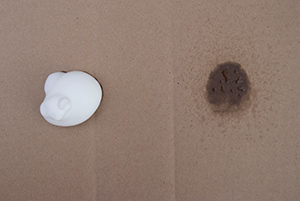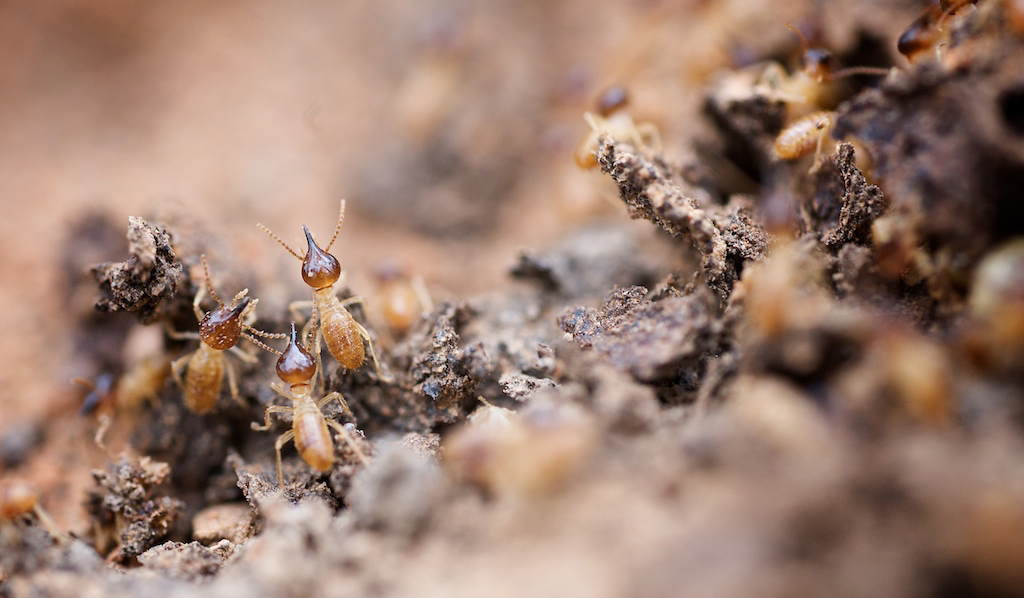Foams are a relatively new tool in the pest management professional’s (PMP’s) fight against difficult-to-manage pests. The concept behind using foams in pest management is simple: They can do anything a liquid insecticide can do, and more.
While extremely handy in a wide range of applications, liquid pesticide has one element that inevitably works against it: gravity. When applied, liquid pesticide cannot flow “up” into a termite gallery or void — it instead flows to the lowest part of the treated area. Foam, on the other hand, can climb up into galleries, voids and other openings, enhancing the effectiveness and accuracy of the application.
The motion of foam:
Foam formulations are typically described as a “dry” foam application, meaning there is little water applied. This is important because, with little water, the product is unlikely to damage paint, walls, wood or other surfaces/voids where applications might be made.

Left: Application of foam pesticide on cardboard. Right: Application of liquid pesticide on cardboard.
Additionally, most foams are non-repellent, so when pests encounter insecticide residue left behind after the foam dries, they do not avoid the treated surfaces. Foam applications are also generally protected from ultraviolet (UV) light, rain and other environmental factors — so the treatment is less likely to be quickly broken down or moved from the application site.
There are many options for PMPs to make and apply pesticide foam. Mechanical foamers powered by electricity; simple hand-pumped compressed air foamers; and commercially available ready-to-use foam in a can — much like shaving cream or hair mousse — are available.
Most commercially available ready-to-use cans of foam have a 30:1 foam expansion ratio. This means, when applied, the volume of foam produced will be 30 times the volume of the foam in the ready-to-use can.
There are many types of pesticides that can be formulated into foam, and there are several commercially available foaming concentrates. However, PMPs should never use a foaming concentrate alone, as there is no active ingredient in it to manage pests.

How to apply foam
In general, foams can be used as a spot and/or crack-and-crevice treatment. Follow the steps below to achieve an effective application.
 Shake the can well.
Shake the can well.
- Hold can upright and away from face.
- Use a sufficient amount of formulated foam to treat the known or suspected insect harborage space.
- Firmly hold the injector tip in place for approximately eight to 10 seconds. This is important. By holding the injector tip in place, the product within the injector tube can dispense and expand into the treatment area. This also helps reduce any clean-up required after application.
- Drill hole(s) at one or more locations along the gallery, harborage or void for proper treatment. Sometimes, accessing the known or suspected gallery, harborage or void may be too difficult, and the PMP will need to drill one or more holes. Once the holes are drilled, use the same method of applying foam and leaving the injector in place. If you are unsure of how far your foam application has spread, use a moisture meter to help determine the extent of the application coverage.
Watch a step-by-step demonstration of a foam application:
Where to apply foam
Traditionally, most foam applications were designed to combat drywood termites and woodboring beetles. Because of their habits of living inside wood, without contact to moisture and in small numbers, foam is an excellent choice for control.
 PMPs should drill a small hole in the wood, with the goal of accessing termite feeding galleries in the wood, and apply the foam. Alternatively, PMPs can use kick-out holes — where frass, or the termites’ excrement, is ejected from galleries — as the location for application.
PMPs should drill a small hole in the wood, with the goal of accessing termite feeding galleries in the wood, and apply the foam. Alternatively, PMPs can use kick-out holes — where frass, or the termites’ excrement, is ejected from galleries — as the location for application.
Other possible sites for application include exposed wooden elements in crawlspaces, basements or attics; unexposed wooden elements inside walls or other structural voids; exterior wooden elements in decks, fencing or siding; channels in damaged wood; in spaces between wooden elements of a structure; and junctions between wood and foundations.
Not just for termites anymore
More recently, foam applications have been used to manage other pests located in hard-to-reach places.
 In addition to managing termites with applications in voids and galleries, foam can be useful in reaching and managing flies infesting drains. PMPs can also use foam for applications in holes and cracks in hollow furniture for bed bug management and for applications in voids while treating for cockroaches.
In addition to managing termites with applications in voids and galleries, foam can be useful in reaching and managing flies infesting drains. PMPs can also use foam for applications in holes and cracks in hollow furniture for bed bug management and for applications in voids while treating for cockroaches.
Some pesticide foam products are not limited to voids, but can also be used for crack-and-crevice applications. Always read and follow the label instructions for the specific product you are applying.

 Fuse Foam
Fuse Foam
Control Solutions Inc. recently launched a revolutionary product into the marketplace — Fuse Foam.
The magic behind Fuse Foam is Combination Chemistry. With one application, you have the benefits of two highly effective active ingredients — fipronil and imidacloprid.
Versatility and accessibility
Fuse Foam is extremely easy to use, with a flexible hose and injection tip. With Fuse Foam, the PMP is not limited to interior applications, but can apply indoors and outdoors. Fuse Foam can be used to manage insects where they are found or suspected to be, including: in nests, galleries, harborages and voids.
Treating locally with Fuse Foam is allowed as part of a larger more extensive treatment as well, adding practicality.
In addition to voids for various pests, Fuse Foam can be applied directly on foraging trails as a spot treatment, giving PMPs another powerful tool in ant management.
Be patient with foam!
Most foams are formulated with non-repellent insecticides. These products are notoriously slow-acting. They take time to control insects, but they get the job done right.
To learn more about Control Solutions Inc. and Fuse Foam, visit www.controlsolutionsinc.com.
Quiz: Further your foam knowledge
Pest management professionals (PMPs) have a variety of tools in their arsenal. While most PMPs require different products to reach different pests, it’s also important to have tools that reach pests in different ways and for different use cases. One unique tool to consider is foam.
Test your knowledge — how much do you know about foam formulations?
Article content was contributed by Dr. Janis Reed, BCE, technical services manager at Control Solutions Inc. This page was produced by North Coast Media’s content marketing staff in collaboration with Control Solutions Inc. NCM Content Marketing connects marketers to audiences and delivers industry trends, business tips and product information. The Pest Management Professional editorial staff did not create this content.
Photos: Termites by Craig Kirkwood, Flickr.com / used under CC BY-SA 2.0; ©iStock.com/zerlik/next143

